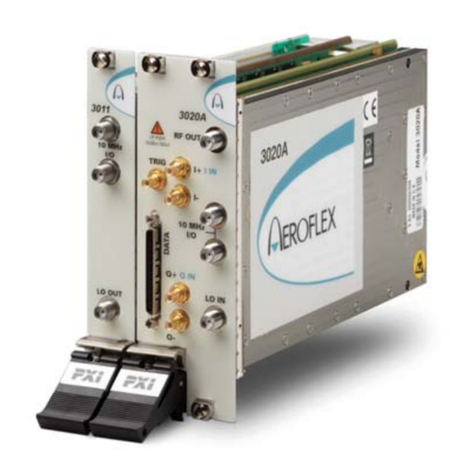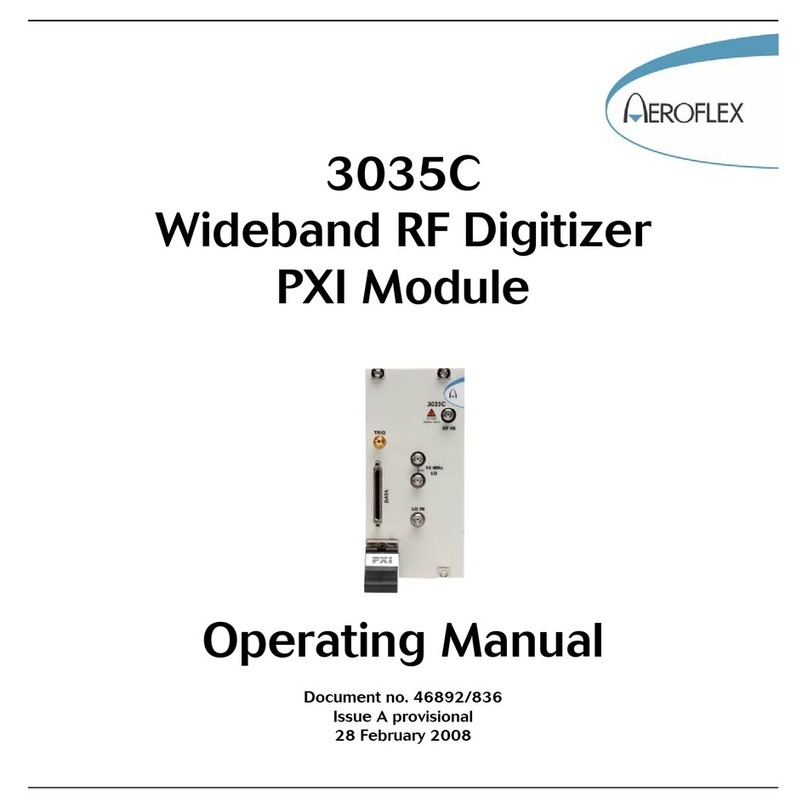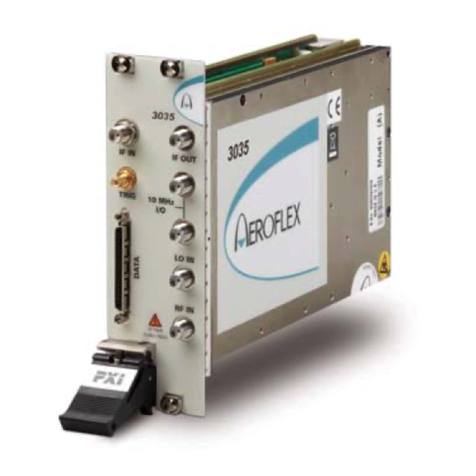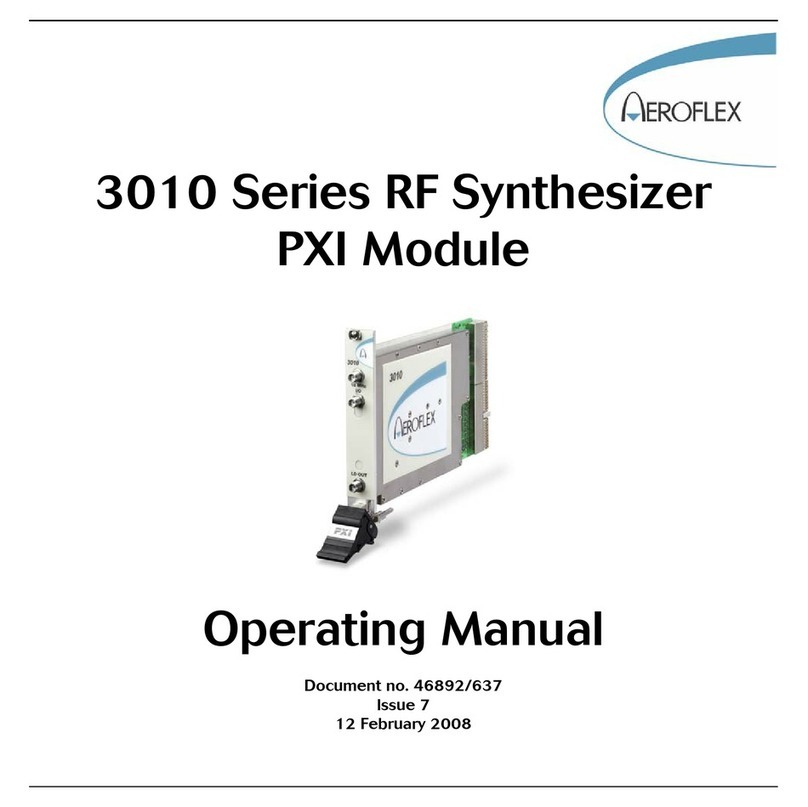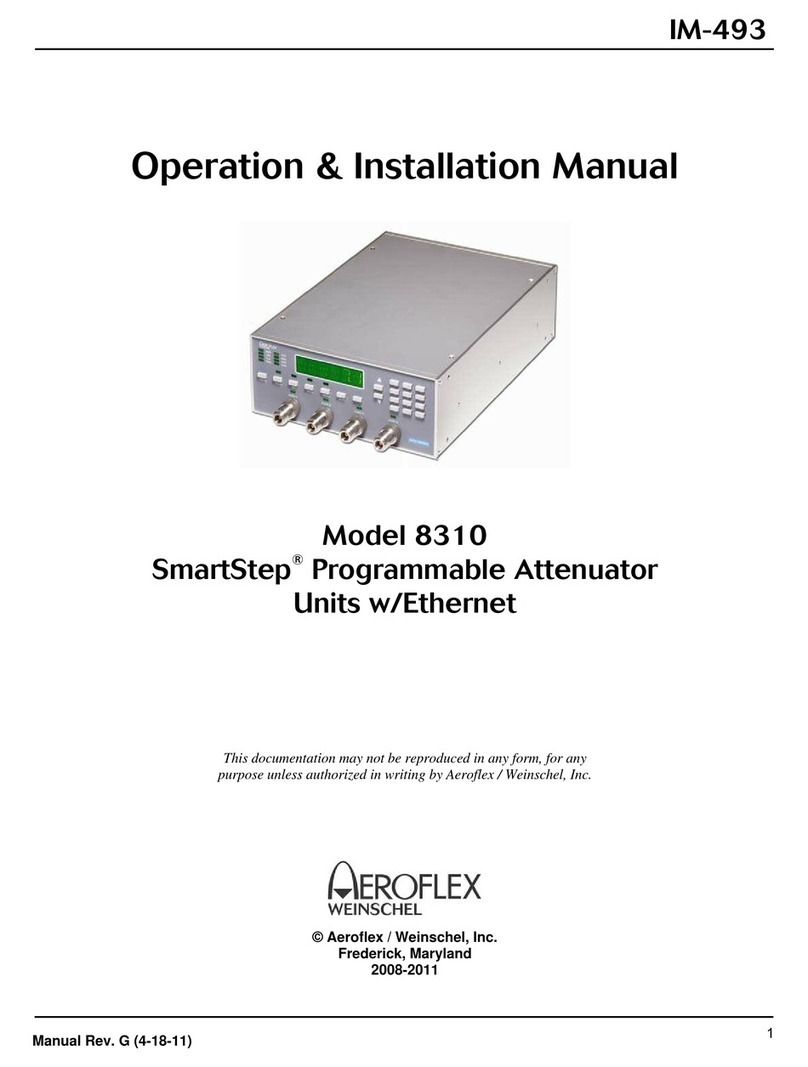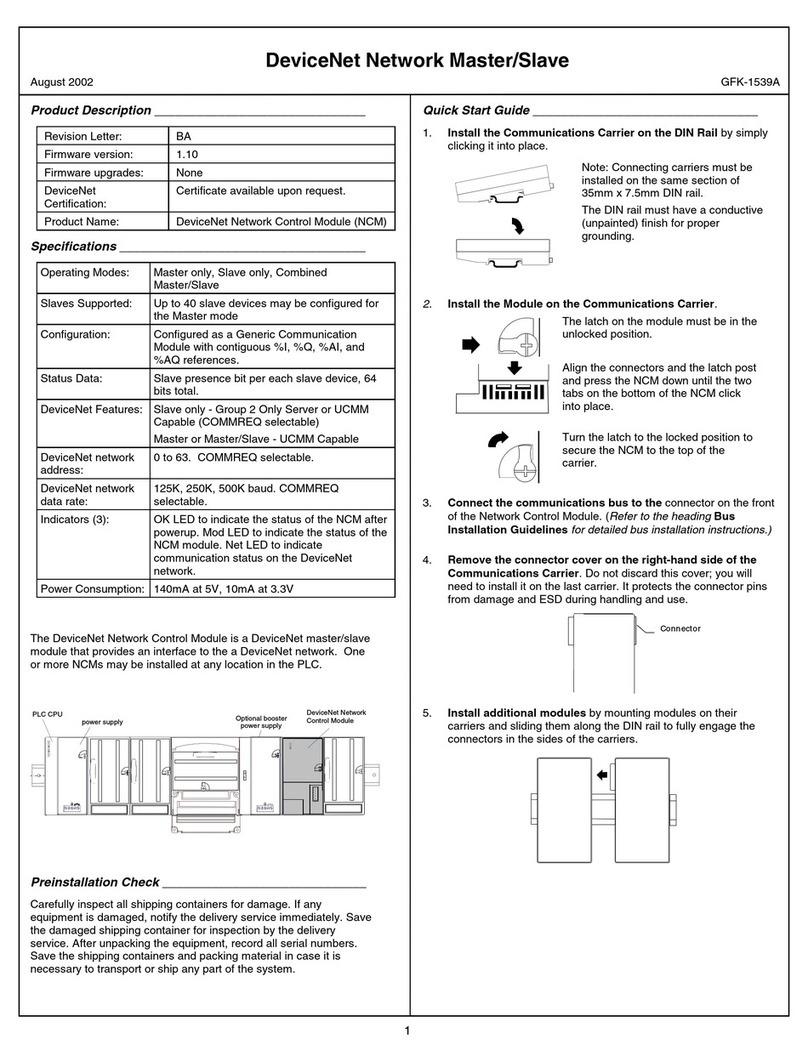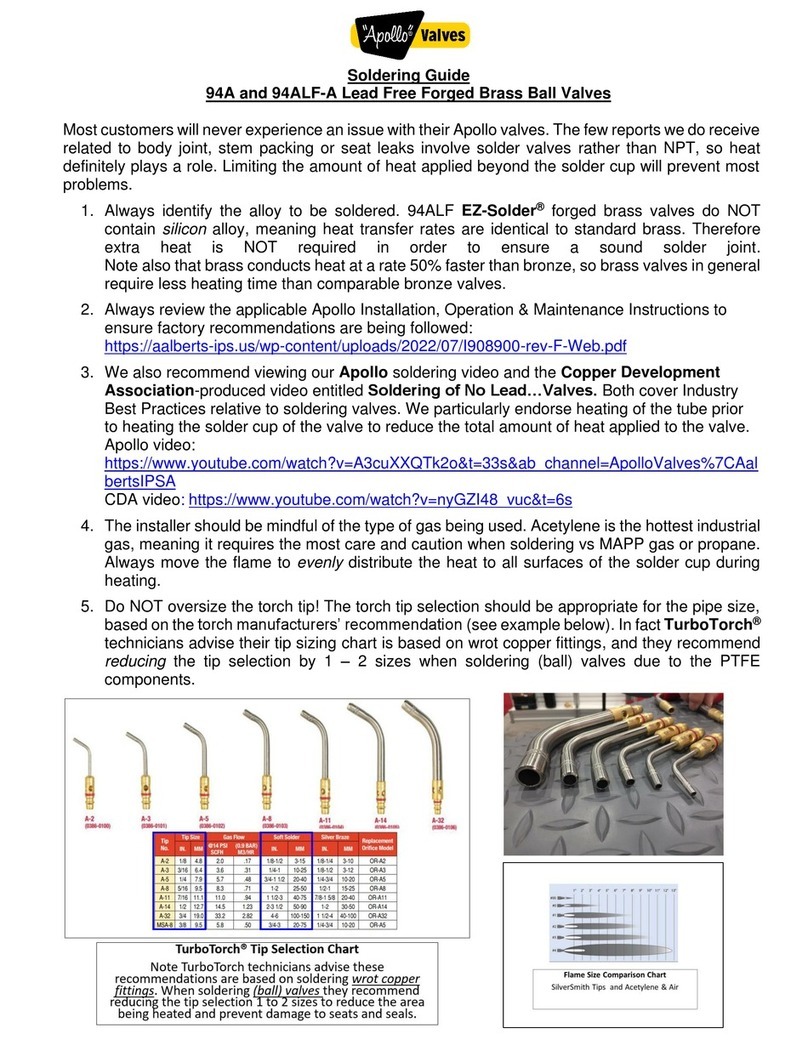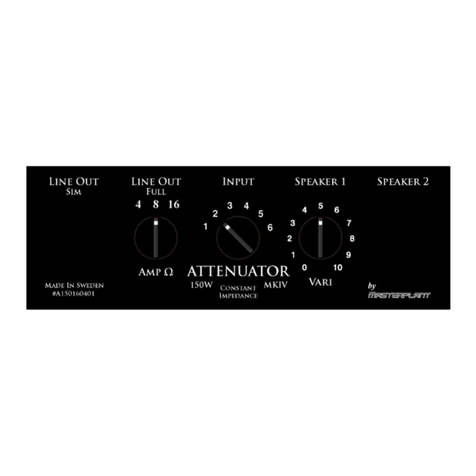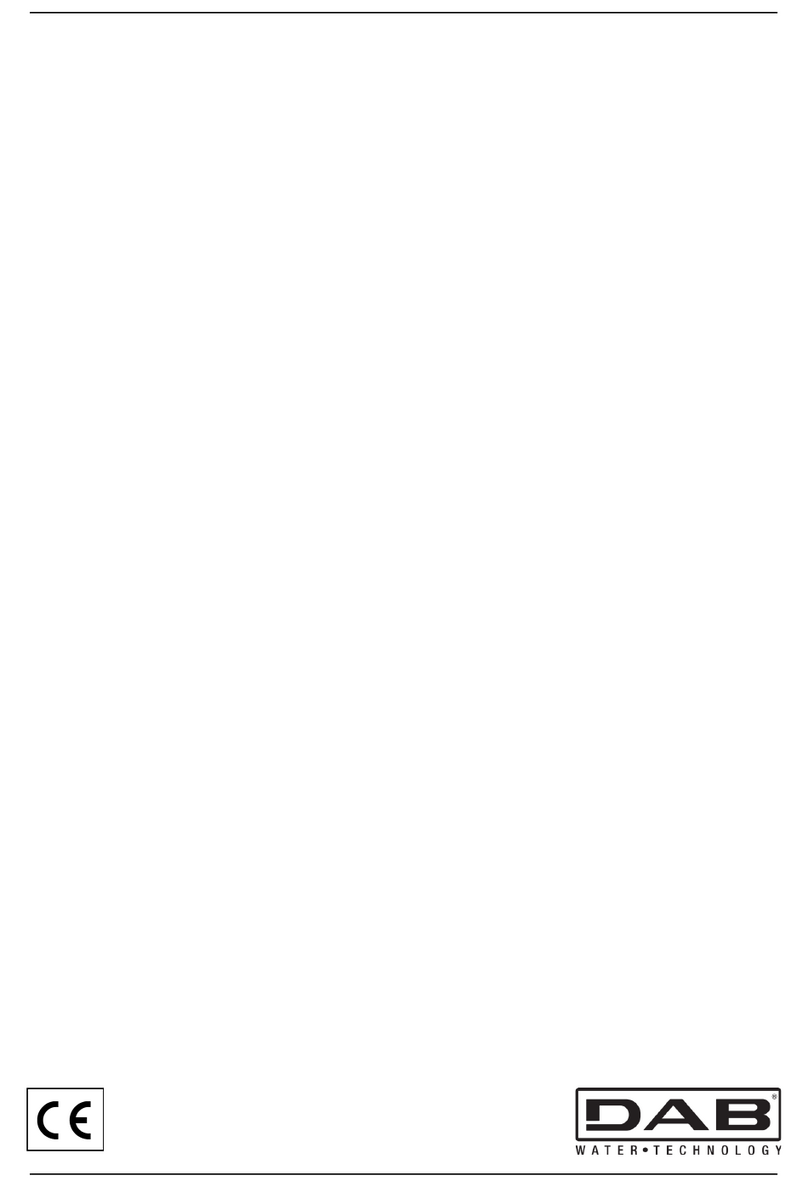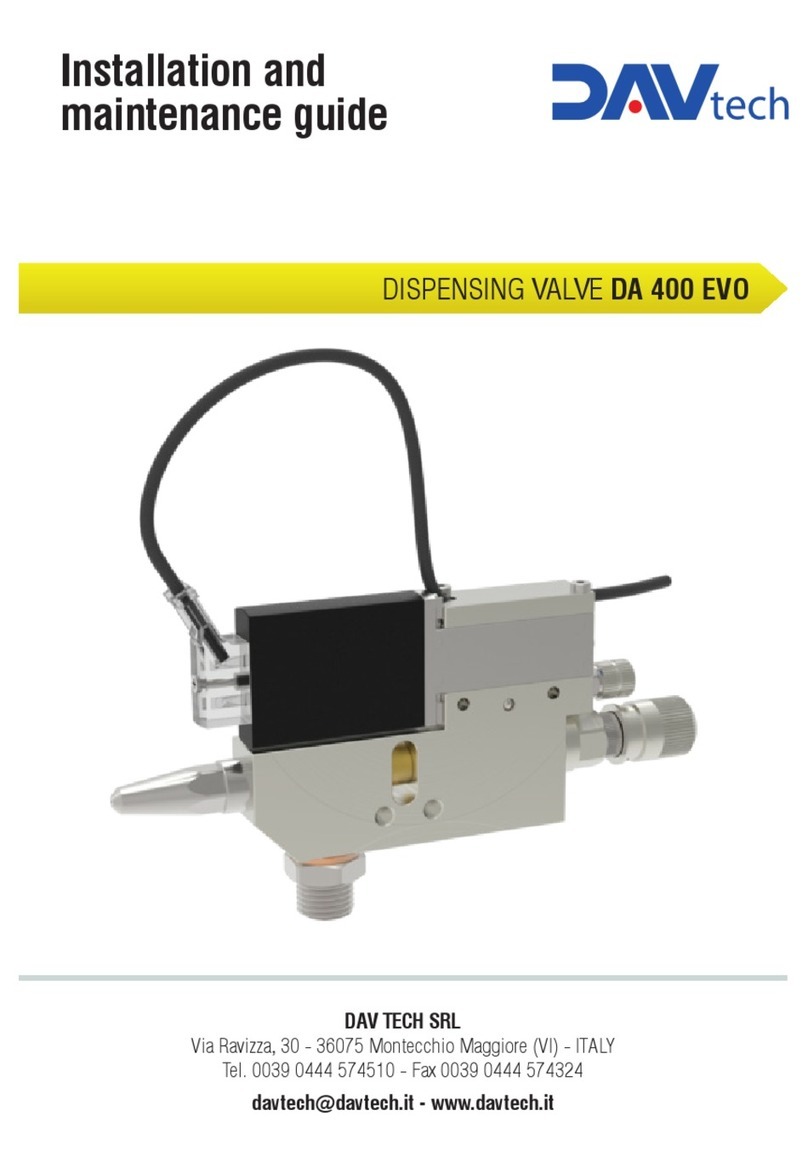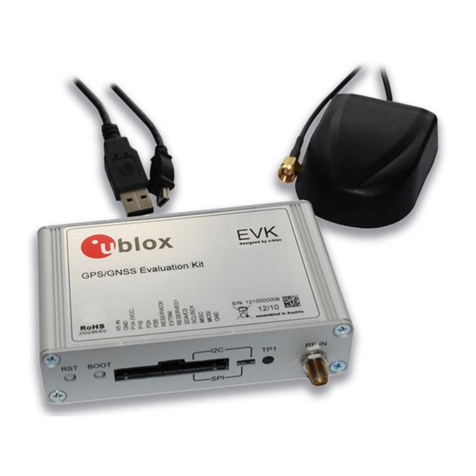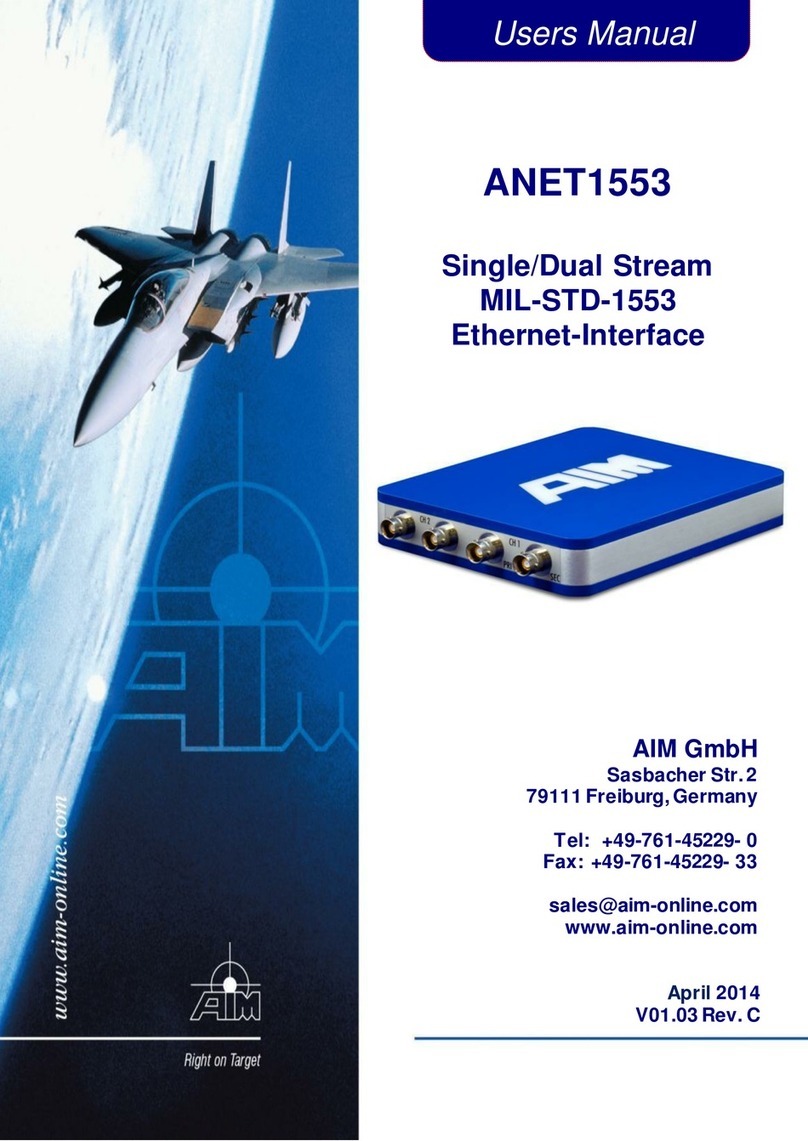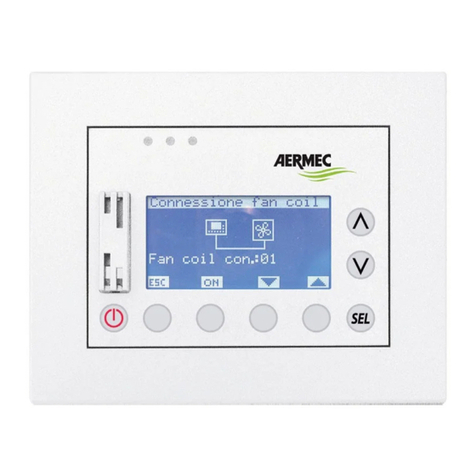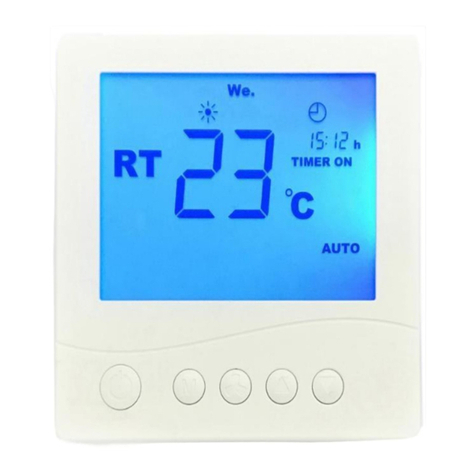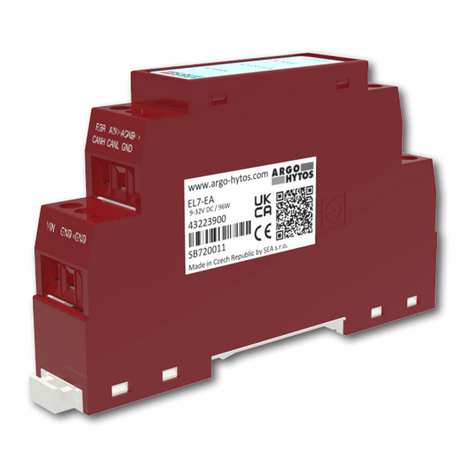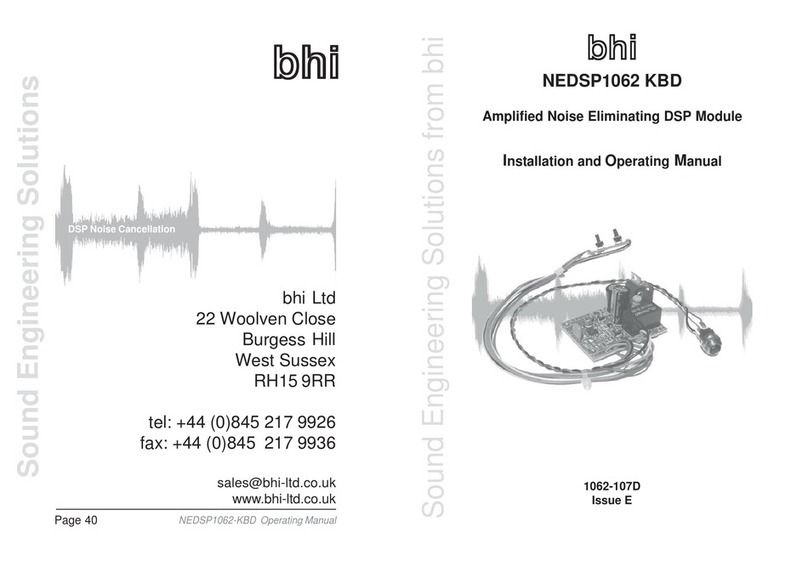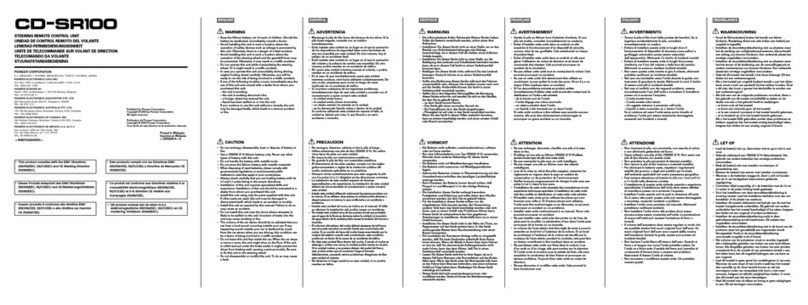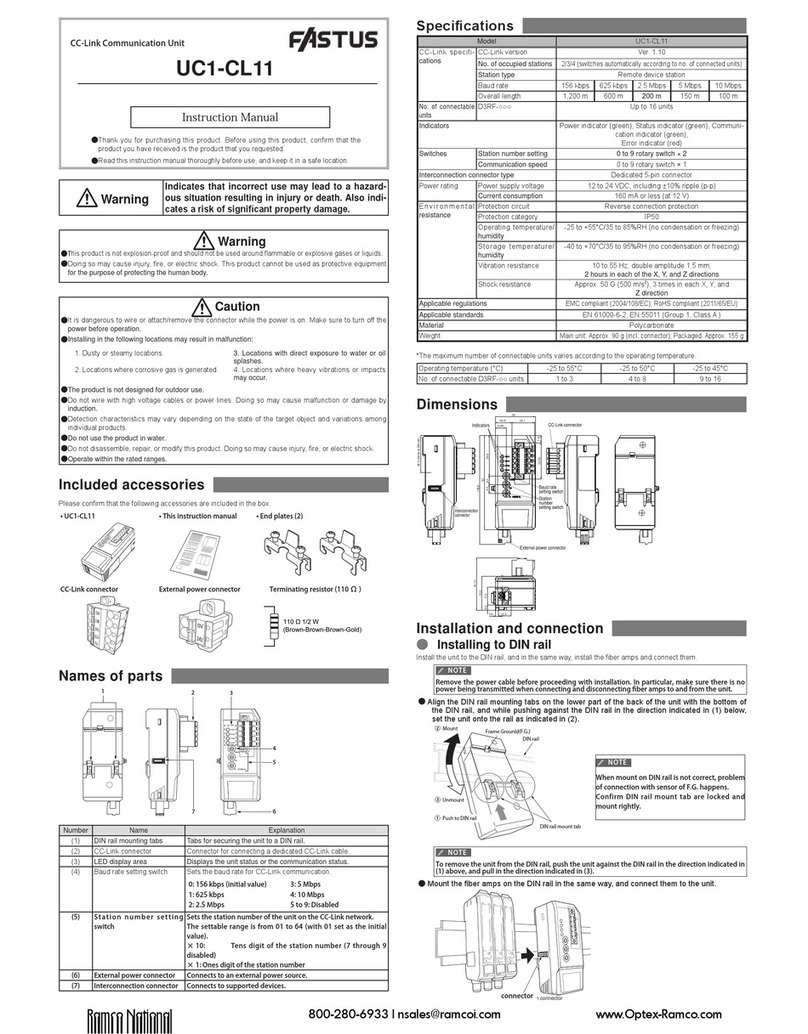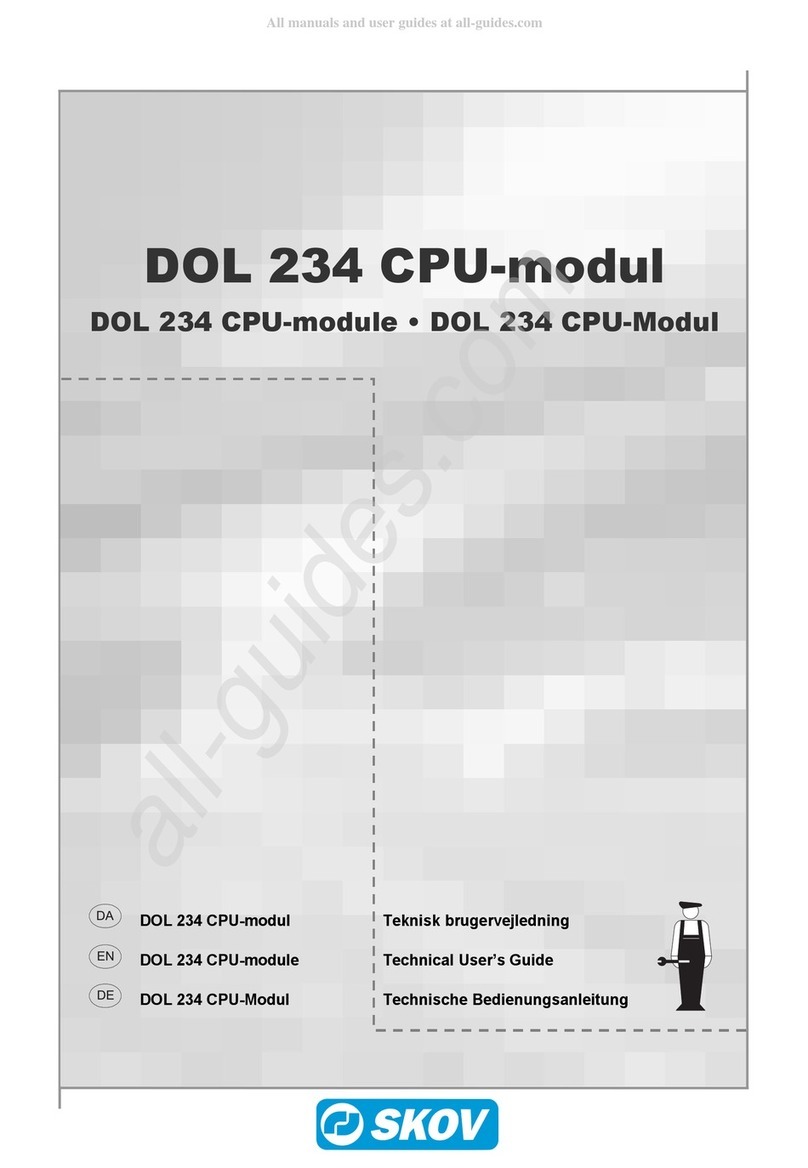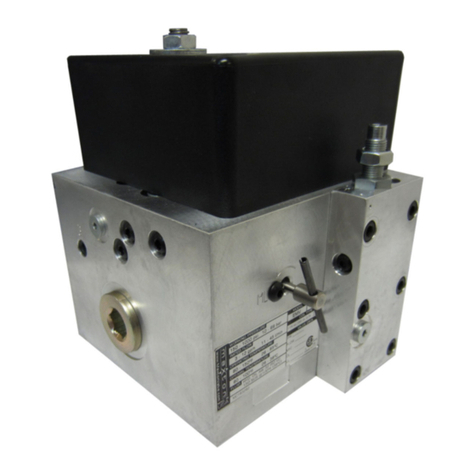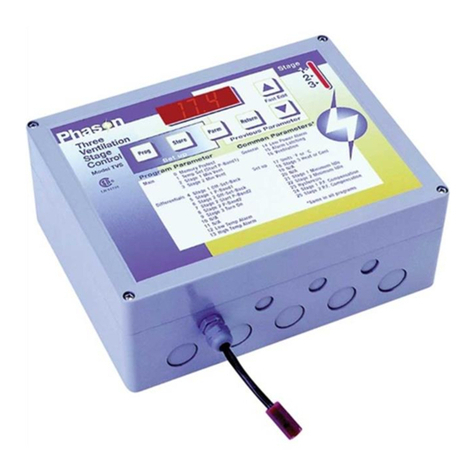Aeroflex 3000 Series User manual

3000 Series PXI Modules
Common Installation Guide
© Aeroflex Ltd. 2010
Longacres House
Six Hills Way
Stevenage SG1 2AN
UK
No part of this document may be reproduced or transmitted in any form
or by any means, electronic or mechanical, including photocopying,
or recorded by any information storage or retrieval system,
without permission in writing by Aeroflex Ltd.
(hereafter referred to throughout the document as ‘Aeroflex’).
Document part no. 46892/663
Issue 13
29 November 2010

INTRODUCTION
ii
Introduction
This installation guide covers all Aeroflex PXI 3000 Series modules.
It explains how to install driver software, and how to fit the module into the chassis.
PXI Studio is a supplied application that helps you to configure two or more modules to create test
instruments and run measurement utilities. Modules are formatted automatically to provide the
chosen measurement capabilities, and soft front panels create virtual instruments with familiar and
intuitive controls.
User manuals
There is a separate user manual for each of the 3010, 3020, 3030 and 3060 Series. Each manual
contains information about connecting and operating the modules, an explanation of the soft front
panel, driver functions, and a simple technical description. All the user manuals are included on
the PXI Modules CD-ROM, part no. 46886/028.
Declaration of Conformity
If you require a copy of the EC Declaration of Conformity for the PXI 3000 Series modules, please
refer to your local representative.
® is a registered trademark of Aeroflex International Inc. in the US
Microsoft® is a registered trademark of Microsoft Corporation
Windows™ and Windows XP™ are trademarks of Microsoft Corporation
N
ational Instruments™ and NI-VISA™ are trademarks of National Instruments Corporation.

INTRODUCTION
iii
Associated documentation
If you want to… Refer to…
Find information about soft front panels,
drivers, application software, data sheets,
installation, getting started and user manuals
for this and other modules in the 3000 Series
PXI Modules CD-ROM, part no. 46886/028
Supplied with the module
Learn about Aeroflex RF synthesizer PXI
modules 3010 Series RF Synthesizer User Manual
Part no. 46890/637
On the CD-ROM and at www.aeroflex.com/pxi
Learn about Aeroflex digital RF signal
generator PXI modules 3020 Series Digital RF Signal Generator User Manual
Part no. 46890/834
On the CD-ROM and at www.aeroflex.com/pxi
Learn about Aeroflex digitizer PXI modules 3020 Series Wideband RF Digitizer User Manual
Part no. 46890/836
On the CD-ROM and at www.aeroflex.com/pxi
Learn about Aeroflex combiner PXI modules 3060 Series RF Combiner User Manual
Part no. 46890/762
On the CD-ROM and at www.aeroflex.com/pxi
Set up a populated chassis ready for use 3000 Series PXI Modules Installation Guide for Chassis
Part no. 46892/667
On the CD-ROM and at www.aeroflex.com/pxi
Set up and use the universal PXI application
for system configuration and operation PXI Studio User Guide
Part no: 46892/809
On the CD-ROM and at www.aeroflex.com/pxi
Set up and use a digitizer application for
3010 Series and 3030 Series modules Getting Started with afDigitizer
Part no. 46892/676
On the CD-ROM and at www.aeroflex.com/pxi
Set up and use a signal generator application
for 3010 Series and 3020 Series modules Getting Started with afSigGen
Part no. 46892/678
On the CD-ROM and at www.aeroflex.com/pxi
Overview, installation, pin assignments and
maintenance information for the 3000 Series
chassis and system controller.
3000/3000B Chassis and 3001B/3001C System Controller User
Guide
Part no. 46892/837
On the CD-ROM and at www.aeroflex.com/pxi
Overview, installation, pin assignments and
maintenance information for the 20-slot
chassis and system controller interface.
82547 and 82548 Chassis and MXIe/MXI-4 System Controller
Interface User Guide
Included in 44540_221 folder on the CD-ROM

iv
Contents
Precautions.......................................................................................................................................v
Précautions................................................................................................................................... viii
Vorsichtsmaßnahmen.....................................................................................................................xi
Precauzioni....................................................................................................................................xiv
Precauciones.................................................................................................................................xvii
Installing a 3000 Series PXI module ..............................................................................................1
Introduction .......................................................................................................................................1
Naming conventions...................................................................................................................1
Unpacking the module.......................................................................................................................1
Contents of packing....................................................................................................................1
Handling precautions..................................................................................................................1
Initial visual check......................................................................................................................2
Typical system...................................................................................................................................3
System requirements..........................................................................................................................3
Tools required....................................................................................................................................3
Software architecture.........................................................................................................................4
Which interface to use? ..............................................................................................................4
Installation process............................................................................................................................5
General.......................................................................................................................................5
Order of installation....................................................................................................................7
Uninstalling PXI module software ....................................................................................................8
Removing previous versions of application software.................................................................8
Driver version....................................................................................................................................9
Checking the software compatibility of a PXI module...............................................................9
Installing PXI module software.......................................................................................................10
Installation locations.................................................................................................................10
Installation procedure...............................................................................................................10
Installing PXI Studio application software......................................................................................15
Installing additional application software packages ........................................................................15
Installing chassis and controller software........................................................................................15
Hardware installation.......................................................................................................................16
Check the safety documentation...............................................................................................16
Installing the 3000 Series module into the chassis...................................................................17
Connecting and torqueing SMA connectors.............................................................................18
For PCI-to-PXI interface kit users............................................................................................18
For PXI embedded controller users..........................................................................................18
Hardware driver installation.....................................................................................................19
Removing the module...............................................................................................................21
Connector maintenance............................................................................................................21
Using the installed software.............................................................................................................22
Running the soft front panel.....................................................................................................22
User manuals............................................................................................................................22
Contents of installation folder ..................................................................................................23
Other installed items.................................................................................................................23
Identifying modules installed in a chassis................................................................................23
Repackaging....................................................................................................................................25

v
Precautions
These terms have specific meanings in this manual:
WARNING
information to prevent personal injury.
information to prevent damage to the equipment.
important general information.
Hazard symbols
The meaning of hazard symbols appearing on the equipment and in the documentation is as
follows:
Symbol Description
Refer to the user manual when this symbol is
marked on the instrument. Familiarize
yourself with the nature of the hazard and the
actions that may have to be taken.
Dangerous voltage
Toxic hazard
General conditions of use
This product is designed and tested to comply with the requirements of IEC/EN61010-1 ‘Safety
requirements for electrical equipment for measurement, control and laboratory use’, for Class III
equipment and is for use in a pollution degree 2 environment. The equipment is designed to
operate from an installation category I supply.
Equipment should be protected from the ingress of liquids and precipitation such as rain, snow,
etc. When moving the equipment from a cold to a hot environment, it is important to allow the
temperature of the equipment to stabilize before it is connected to the supply to avoid condensation
forming. The equipment must only be operated within the environmental conditions specified in
the data sheet, otherwise the protection provided by the equipment may be impaired.
This product is not approved for use in hazardous atmospheres or medical applications. If the
equipment is to be used in a safety-related application, e.g. avionics or military applications, the
suitability of the product must be assessed and approved for use by a competent person.

PRECAUTIONS
vi
WARNING
Electrical hazards (DC supply voltage)
This equipment conforms with IEC safety Class III, meaning that for continued safety it must only
be connected to supplies and signal sources which conform to ‘Separated Extra-Low Voltage’
(SELV and SELV-E) voltage and insulation requirements. No hazardous voltages are generated
internally. See the data sheet for the maximum permitted voltage levels that can be applied.
Do not remove instrument covers as this may result in personal injury. There are no user-
serviceable parts inside.
Refer all servicing to qualified personnel. See list of Service Centers at rear of manual.
WARNING
Toxic hazards
Some of the components used in this equipment may include resins and other materials which give
off toxic fumes if incinerated. Take appropriate precautions, therefore, in the disposal of these
items.
WARNING
Beryllium copper
It is possible that some mechanical components within this instrument may be manufactured from
beryllium copper. This is an alloy with a beryllium content of approximately 5%. It represents no
risk in normal use.
The material should not be machined, welded or subjected to any process where heat is involved.
It must be disposed of as “special waste”.
It must NOT be disposed of by incineration.
WARNING
Hot surfaces
Take care when touching a module which has run for a prolonged period; the surface temperature
can become high.
WARNING
Short circuited/bent pins in chassis
Before installing the module into the chassis, check inside the chassis that no foreign conductors
are present between pins on the backplane connectors and that no pins on the backplane connectors
are bent or damaged.
Static sensitive components
This equipment contains static sensitive components which may be damaged by handling.

PRECAUTIONS
vii
Suitability for use
This equipment has been designed and manufactured by Aeroflex to generate low-power RF
signals for testing radio communications apparatus and to digitize and provide spectrum analysis
of RF signals.
If the equipment is not used in a manner specified by Aeroflex, the protection provided by the
equipment may be impaired.
Aeroflex has no control over the use of this equipment and cannot be held responsible for events
arising from its use other than for its intended purpose.

PRECAUTIONS
viii
Précautions
Les termes suivants ont, dans ce manuel, des significations particulières:
WARNING
contient des informations pour éviter toute blessure au personnel.
contient des informations pour éviter les dommages aux équipements.
contient d'importantes informations d'ordre général.
Symboles signalant un risque
La signification des symboles de danger apparaissant sur l'équipement et dans la documentation est
la suivante:
Symbole Nature du risque
Reportez-vous au manuel d'utilisation quand
ce symbole apparaît sur l'instrument.
Familiarisez-vous avec la nature du danger et
la conduite à tenir.
Tension dangereuse
Danger produits toxiques
Conditions générales d’utilisation
Ce produit a été conçu et testé pour être conforme aux exigences des normes CEI/EN61010-1
“Règles de sécurité pour appareils électriques de mesurage, de régulation et de laboratoire”, pour
des équipements Classe III et pour une utilisation dans un environnement de pollution de niveau 2.
Cet équipement est conçu pour fonctionner à partir d’une alimentation de catégorie I.
Cet équipement doit être protégé de l’introduction de liquides ainsi que des précipitations d’eau, de
neige, etc... Lorsqu’on transporte cet équipement d’un environnement chaud vers un
environnement froid, il est important de laisser l’équipement se stabiliser en température avant de
le connecter à une alimentation afin d’éviter toute formation de condensation. L'appareil doit être
utilisé uniquement dans le cadre des conditions d'environnement spécifiées dans la fiche technique,
toute autre utilisation peut endommager les systèmes de protection.
Ce produit n’est pas garanti pour fonctionner dans des atmosphères dangereuses ou pour un usage
médical. Si l'équipement doit être utilisé pour des applications en relation avec la sécurité, par
exemple des applications militaires ou aéronautiques, la compatibilité du produit doit être établie et
approuvée par une personne compétente.

PRECAUTIONS
ix
WARNING
Sécurité électrique (tension d’alimentation continue)
Cet équipement est conforme aux normes de sécurité CEI Classe III, c’est-à-dire qu’il ne doit être
connecté qu’à des sources d’alimentation ou de signaux qui suivent les recommandations de
tension et d’isolement du type ‘Tension extra-faible séparée’ (SELV at SELV-E). Aucune tension
dangereuse n’est générée en interne. La fiche technique précise les niveaux de tension maximum
acceptables en entrée.
Ne démontez pas le capot de l'instrument, car ceci peut provoquer des blessures. Il n'y a pas de
pièces remplaçables par l'utilisateur à l'intérieur.
Faites effectuer toute réparation par du personnel qualifié. Contacter un des Centres de
Maintenance Internationaux dans la liste jointe à la fin du manuel.
WARNING
Danger produits toxiques
Certains composants utilisés dans cet appareil peuvent contenir des résines et d'autres matières qui
dégagent des fumées toxiques lors de leur incinération. Les précautions d'usages doivent donc être
prises lorsqu'on se débarrasse de ce type de composant.
WARNING
Bronze au béryllium
Il est possible que dans cet équipement,certaines pièces mécaniques sont à base de bronze au
béryllium. Il s'agit d'un alliage dans lequel le pourcentage de béryllium ne dépasse pas 5%. Il ne
présente aucun danger en utilisation normale.
Toutefois, cet alliage ne doit pas être travaillé, soudé ou soumis à un processus qui implique
l'utilisation d'une source de chaleur.
En cas de destruction, il sera entreposé dans un container spécial. IL ne devra pas être détruit par
incinération.
WARNING
Surfaces chaudes
Faites attention en touchant un module qui a fonctionné pendant une période prolongée; la
température de surface peut devenir haute.
WARNING
Court circuit / broches tordues dans le châssis
Avant d'installer le module dans le châssis, vérifiez l'intérieur du châssis qu'aucun des conducteurs
étrangers ne sont présents entre les broches sur les connecteurs de fond de panier et qu'aucune
broches sur les connecteurs de fond de panier ne sont tordues ou endommagées.

PRECAUTIONS
x
Utilisation
Cet équipement a été conçu et fabriqué par Aeroflex pour générer des signaux RF de faible
puissance pour le test d'appareils de radio communications et numériser et analyser le spectre de
signaux RF.
La protection de l'équipement peut être altérée s'il n'est pas utilisé dans les conditions spécifiées
par Aeroflex. Aeroflex n'a aucun contrôle sur l'usage de l'instrument, et ne pourra être tenu pour
responsable en cas d'événement survenant suite à une utilisation différente de celle prévue.

PRECAUTIONS
xi
Vorsichtsmaßnahmen
Diese Hinweise haben eine bestimmte Bedeutung in diesem Handbuch:
WARNING
dienen zur Vermeidung von Verletzungsrisiken.
dienen dem Schutz der Geräte.
enthalten wichtige Informationen.
Gefahrensymbole
Die Bedeutung der Gefahrensymbole auf den Geräten und in der Dokumentation ist wie folgt:
Symbol Gefahrenart
Beziehen Sie sich auf die
Bedienungsanleitung wenn das Messgerät mit
diesem Symbol markiert ist. Machen Sie sich
mit der Art der Gefahr und den Aktionen die
getroffen werden müssen bekannt.
Gefährliche Spannung
Warnung vor giftigen Substanzen
Allgemeine Hinweise zur Verwendung
Dieses Produkt wurde entsprechend den Anforderungen von IEC/EN61010-1
“Sicherheitsanforderungen für elektrische Ausrüstung für Meßaufgaben, Steuerung und
Laborbedarf”, Klasse III, zur Verwendung in einer Grad 2 verunreinigten Umgebung, entwickelt
und getestet. Dieses Gerät ist für Netzversorgung Klasse I zugelassen.
Das Gerät sollte vor dem Eindringen von Flüssigkeiten sowie vor Regen, Schnee etc. geschützt
werden. Bei Standortänderung von kalter in wärmere Umgebung sollte das Gerät wegen der
Kondensation erst nach Anpassung an die wärmere Umgebung mit dem Netz verbunden werden.
Das Gerät darf nur in Umgebungsbedingungen wie im Datenblatt beschrieben, betrieben werden;
ansonsten wird der vom Gerät vorgesehene Schutz des Anwenders beeinträchtigt.
Dieses Produkt ist nicht für den Einsatz in gefährlicher Umgebung (z.B. Ex-Bereich) und für
medizinische Anwendungen geprüft. Sollte das Gerät für den Einsatz in sicherheitsrelevanten
Anwendungen wie z.B. im Flugverkehr oder bei militaerischen Anwendungen vorgesehen sein, so
ist dieser von einer für diesen Bereich zuständigen Person zu beurteilen und genehmigen.

PRECAUTIONS
xii
WARNING
Elektrische Schläge (Gleichspannungsversorgung)
Dieses Gerät entspricht der IEC Sicherheitsklasse III. Aus Sicherheitsgründen darf es nur an
Netzgeräte und Signalquellen angeschlossen werden, die in Spannung und Isolation der SELV und
SELV-E Richtlinie genügen (“Getrennte Niederspannung”). Im Gerät werden keine gefährlichen
Spannungen erzeugt. Im Datenblatt werden die anschließbaren Höchstspannungen definiert.
Öffnen Sie niemals das Gehäuse der Geräte das dies zu ernsthaften Verletzungen führen kann. Es
gibt keine vom Anwender austauschbare Teile in diesem Gerät.
WARNING
Warnung vor giftigen Substanzen
In einigen Bauelementen dieses Geräts können Epoxyharze oder andere Materialien enthalten sein,
die im Brandfall giftige Gase erzeugen. Bei der Entsorgung müssen deshalb entsprechende
Vorsichtsmaßnahmen getroffen werden.
WARNING
Beryllium Kupfer
Es ist möglich, dass in diesem Gerät sind einige mechanische Komponenten aus Berylium Kupfer
gefertigt. Dies ist eine Verbindung welche aus einem Berylliumanteil von ca. 5 % besteht. Bei
normaler Verwendung besteht kein Gesundheitsrisiko.
Das Metall darf nicht bearbeitet, geschweißt oder sonstiger Wärmebehandlung ausgesetzt werden.
Es muß als Sondermüll entsorgt werden.
Es darf nicht durch Verbrennung entsorgt werden.
WARNING
Heiße Oberfläche
Vorsicht bei Berührung eines Moduls das während eines verlängerten Zeitraums gelaufen ist; die
Oberflächentemperatur kann hoch werden.
WARNING
Kurzgeschlossen / verbogene Pins im Chassis
Vor dem Einbau des Moduls in das Chassis, überprüfen Sie innerhalb des Chassis, dass keine
ausländischen Dirigenten präsentieren zwischen den Stiften auf der Backplane-Steckverbinder sind
und dass keine Pins auf der Backplane-Steckverbinder verbogen oder beschädigt sind.

PRECAUTIONS
xiii
Eignung für Gebrauch
Dieses Gerät wurde von Aeroflex entwickelt und hergestellt um HF Signale geringer Leistung zum
Test von Kommunikationseinrichtungen zu erzeugen und HF Signale zu digitalisieren und
Spektrumanalyse an HF Signalen durchzuführen.
Sollte das Gerät nicht auf die von Aeroflex vorgesehene Art und Weise verwendet werden, kann
die Schutzfunktion des Gerätes beeinträchtigt werden.
Aeroflex hat keinen Einfluß auf die Art der Verwendung und übernimmt keinerlei Verantwortung
bei unsachgemässer Handhabung.

PRECAUTIONS
xiv
Precauzioni
Questi termini vengono utilizzati in questo manuale con significati specifici:
WARNING
riportano informazioni atte ad evitare possibili pericoli alla persona.
riportano informazioni per evitare possibili pericoli all'apparecchiatura.
riportano importanti informazioni di carattere generale.
Simboli di pericolo
Il significato del simbolo di pericolo riportato sugli strumenti e nella documentazione è il seguente:
Simbolo Tipo di pericolo
Fare riferimento al manuale operativo quando
questo simbolo è riportato sullo strumento.
Rendervi conto della natura del pericolo e
delle precauzioni che dovrete prendere.
Tensione pericolosa
Pericolo sostanze tossiche
Condizioni generali d’uso
Questo prodotto è stato progettato e collaudato per rispondere ai requisiti della direttiva
IEC/EN61010-1 ‘Safety requirements for electrical equipment for measurement, control and
laboratory use’ per apparati di classe III, per l’uso in un ambiente inquinato di grado 2. L’apparato
è stato progettato per essere alimentato da un alimentatore di categoria I.
Lo strumento deve essere protetto dal possibile ingresso di liquidi quali, ad es., acqua, pioggia,
neve, ecc. Qualora lo strumento venga portato da un ambiente freddo ad uno caldo, è importante
lasciare che la temperatura all’interno dello strumento si stabilizzi prima di alimentarlo per evitare
formazione di condense. Lo strumento deve essere utilizzato esclusivamente nelle condizioni
ambientali descritte nella scheda tecnica, in caso contrario le protezioni previste nello strumento
potrebbero risultare non sufficienti.
Questo prodotto non è stato approvato per essere usato in ambienti pericolosi o applicazioni
medicali. Se lo strumento deve essere usato per applicazioni particolari collegate alla sicurezza
(per esempio applicazioni militari o avioniche), occorre che una persona o un istituto competente
ne certifichi l'uso.

PRECAUTIONS
xv
WARNING
Pericoli da elettricità (alimentazione a c.c.)
Questo strumento rispetta le norme IEC, classe III, e quindi, per una completa sicurezza, deve
essere collegato solo ad alimentatori e generatori di segnali che rispettano I requisiti di tensione ed
isolamento SELV e SELV-E (Separated Extra-Low Voltage). Nessuna tensione pericolosa è
generata al suo interno. Vedi la scheda tecnica per quanto concerne I livelli massimi di tensione
applicabili.
Non rimuovete mai le coperture perché così potreste provocare danni a voi stessi. Non vi sono
all’interno parti di interesse all’utilizzatore.
Tutte gli interventi sono di competenza del personale qualificato. Vedi elenco internazionale dei
Centri di Assistenza in fondo al manuale.
WARNING
Pericolo sostanze tossiche
Alcuni dei componenti usati in questo strumento possono contenere resine o altri materiali che, se
bruciati, possono emettere fumi tossici. Prendere quindi le opportune precauzioni nell'uso di tali
parti.
WARNING
Rame berillio
E possibile que alcuni componenti meccanici in questo strumento sono realizzati in rame berillio.
Si tratta di una lega con contenuto di berillio di circa il 5%, che non presenta alcun rischio in usi
normali.
Questo materiale non deve essere lavorato, saldato o subire qualsiasi processo che coinvolge alte
temperature.
Deve essere eliminato come "rifiuto speciale". Non deve essere eliminato tramite "inceneritore".
WARNING
Superfici ad alta temperatura
Fare attenzione nel toccare un modulo che ha funzionato per un periodo prolungato; la temperatura
in superficie può diventare molto elevata.
WARNING
Cortocircuito / pins piegati nello chassis
Prima di installare il modulo nello chassis, verificare all'interno dello chassis che non conduttori
stranieri sono presenti tra i pin dei connettori backplane e che nessun pin del connettore backplane
siano piegati o danneggiati.

PRECAUTIONS
xvi
Caratteristiche d’uso
Questo strumento è stato progettato e prodotto da Aeroflex generare segnali RF in bassa potenza
per provare apparati di radio comunicazione e digitalizzare ed eseguire analisi di spettro su segnali
RF.
Se lo strumento non è utilizzato nel modo specificato da Aeroflex, le protezioni previste sullo
strumento potrebbero risultare inefficaci.
Aeroflex non può avere il controllo sull’uso di questo strumento e non può essere ritenuta
responsabile per eventi risultanti da un uso diverso dallo scopo prefisso.

PRECAUTIONS
xvii
Precauciones
Estos términos tienen significados específicos en este manual:
WARNING
contienen información referente a prevención de daños personales.
contienen información referente a prevención de daños en equipos.
contienen información general importante.
Símbolos de peligro
El significado de los símbolos de peligro en el equipo y en la documentación es el siguiente:
Símbolo Naturaleza del peligro
Vea el manual de funcionamiento cuando
este símbolo aparezca en el instrumento.
Familiarícese con la naturaleza del riesgo y
con las acciones que deban de tomarse.
Voltaje peligroso
Aviso de toxicidad
Condiciones generales de uso
Este producto ha sido diseñado y probado para cumplir los requerimientos de la normativa
IEC/EN61010-1 “Requerimientos de la normativa para equipos eléctricos de medida, control y uso
en laboratorio”, para equipos clase III, para uso en un ambiente con un grado de contaminación 2.
El equipo ha sido diseñado para funcionar sobre una instalación de alimentación de categorías I.
Debe protegerse el equipo de la entrada de líquidos y precipitaciones como nieve, lluvia, etc.
Cuando se traslada el equipo de entorno frío a un entorno caliente, es importante aguardar la
estabilización el equipo para evitar la condensación. Solamente debe utilizarse el equipo bajo las
condiciones ambientales especificadas en la Hoja Técnica, en caso contrario la propia protección
del equipo puede resultar dañada.
Este producto no ha sido aprobado para su utilización en entornos peligrosos o en aplicaciones
médicas. Si se va a utilizar el equipo en una aplicación con implicaciones en cuanto a seguridad,
como por ejemplo aplicaciones de aviónica o militares, es preciso que un experto competente en
materia de seguridad apruebe su uso.

PRECAUTIONS
xviii
WARNING
Nivel peligroso de electricidad (tensión de alimentación DC)
Este equipo cumple con la norma de seguridad IEC clase III, lo que significa que para total
seguridad debe ser conectado a alimentaciones y fuentes de señal que cumplan los requerimientos
de tensión y aislamiento “Tensión Separada Extra-Baja” (SELV y SELV-E). Ninguna tensión
generada internamente implica riesgo para el operario.
En la Hoja Técnica podrá encontrar los valores máximos permitidos que pueden aplicarse.
No retire las cubiertas del chasis del instrumento, ya que pudiera resultar dañado personalmente.
No existen partes que puedan ser reparadas en su interior.
Deje todas las tareas relativas a reparación a un servicio técnico cualificado. Vea la lista de
Centros de Servicios Internacionales en la parte trasera del manual.
WARNING
Aviso de toxicidad
Alguno de los componentes utilizados en este equipo pudieran incluir resinas u otro tipo de
materiales que al arder produjeran sustancias tóxicas. Por tanto, tome las debidas precauciones en
la manipulación de esas piezas.
WARNING
Berilio-cobre
Es posible que algunos componentes mecánicos contenidos en este instrumento incorporan berilio-
cobre en su proceso de fabricación. Se trata de una aleación con un contenido aproximado de
berilio del 5%, lo que no representa ningún riesgo durante su uso normal.
El material no debe ser manipulado, soldado, ni sometido a ningún proceso que implique la
aplicación de calor.
Para su eliminación debe tratarse como un "residuo especial". El material NO DEBE eliminarse
mediante incineración.
WARNING
Superficies a altas temperaturas
Tenga cuidado al tocar un módulo que ha funcionado por un período prolongado; la temperatura
superficial puede llegar a ser alta.
WARNING
Cortocircuito / pines doblados en el chasis
Antes de instalar el módulo en el chasis, revisar el interior del chasis que no conductores
extranjeros están presentes entre los pines en los conectores de la placa madre y que no pines en
los conectores del backplane están doblados o dañados.

PRECAUTIONS
xix
Idoneidad de uso
Este equipo ha sido diseñado y fabricado por Aeroflex para generar señales de VHF y UHF de bajo
nivel de potencia para prueba de equipos de radiocomunicaciones y para digitalizar y realizar
análisis espectral de señales RF.
Si el equipo fuese utilizado de forma diferente a la especificada por Aeroflex, la protección
ofrecida por el equipo pudiera quedar reducida.
Aeroflex no tiene control sobre el uso de este equipo y no puede, por tanto, exigirsele
responsabilidades derivadas de una utilización distinta de aquellas para las que ha sido diseñado.

1
Installing a 3000 Series PXI module
Introduction
This guide explains how to install and configure your Aeroflex 3000 Series PXI module.
More detailed information about the module, how to operate it and how it works, is given in the
relevant User Manual. This is a PDF document on the PXI Modules CD-ROM packaged with
your module (see here for details), which is installed by default to the same location as the VISA
software when you carry out the software installation.
Please read the cautions and instructions below before installing the module into the PXI chassis.
Naming conventions
‘3000 Series’ is the generic name for any Aeroflex PXI module.
‘3010 Series’ includes 3010, 3011 and 3015 RF synthesizer modules.
‘3020 Series’ includes 3020A, 3020C, 3021C, 3025, 3025C and 3026C RF synthesizer modules.
‘3030 Series’ includes 3030A, 3030C, 3035, 3035C and 3036 RF digitizer modules.
‘3060 Series’ includes 3060, 3061 and 3065 RF combiner modules.
Unpacking the module
Contents of packing
•3000 Series module
•PXI Modules CD-ROM part number 46886/028, containing:
software installer
drivers and soft front panels, including FFT spectrum analysis library
Common Installation Guide (this document)
Installation Guide for Chassis
User Manuals for all 3000 Series PXI modules
application software, including RF Investigator, PXI Studio
PXI version information software
product specifications.
•Module test results CD-ROM part number 46886/054.
•Link cable(s)
Handling precautions
Do not remove the module from its protective packaging until you are ready to insert it into the
chassis.
Avoid static damage by wearing a wrist strap or by touching a good ground frequently whilst
handling the module.
Be especially careful not to touch connectors.
DO NOT insert or remove a module while the chassis is powered up — the module will probably
be damaged.
This manual suits for next models
21
Table of contents
Other Aeroflex Control Unit manuals
